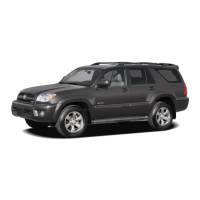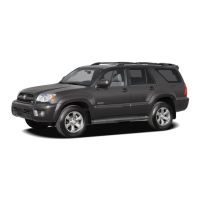94
4RUNNER (EM03M0U)
Engine Control for 1GR–FE
The engine control system utilizes a microcomputer and maintains overall control of the engine, transmission etc. An outline
of the engine control is given here.
1. Input Signals
(1) Engine coolant temp. signal circuit
The engine coolant temp. sensor detects the engine coolant temp. and has a built–in thermistor with a resistance which
varies according to the engine coolant temp. The engine coolant temp. is input into TERMINAL THW of the engine
control module as a control signal.
(2) Intake air temp. signal circuit
The intake air temp. sensor is installed in the mass air flow meter and detects the intake air temp., which is input as a
control signal to TERMINAL THA of the engine control module.
(3) Oxygen sensor signal circuit
The oxygen density in the exhaust emission is detected and is input as a control signal from the heated oxygen sensors
to TERMINALS OX1B and OX2B of the engine control module.
(4) RPM signal circuit
The camshaft position is detected by the VVT sensor (Bank 1) and (Bank 2), and is input into TERMINALS VV1+ and
VV2+ of the engine control module as a control signal. Also, the engine RPM is detected by the crankshaft position
sensor and the signal is input into TERMINAL NE+ of the engine control module.
(5) Throttle position sensor signal circuit
The throttle position sensor detects the throttle valve opening angle as a control signal, which is input into TERMINALS
VTA1 and VTA2 of the engine control module.
(6) Vehicle speed circuit
The vehicle speed sensor detects the vehicle speed, and the signal is input into TERMINAL SPD of the engine control
module via the combination meter, from TERMINAL SP1 of the skid control ECU with actuator.
(7) Battery signal circuit
Voltage is constantly applied to TERMINAL BATT of the engine control module. When the ignition SW is turned on, the
voltage for engine control module start up power supply is applied through the EFI relay, to TERMINALS +B and +B2 of
the engine control module. The current from the IGN fuse flows to TERMINAL IGSW of the engine control module, and
voltage is constantly applied to TERMINAL +BM.
(8) Intake air volume signal circuit
The intake air volume is detected by the mass air flow meter, and is input as a control signal to TERMINAL VG of the
engine control module.
(9) Stop light SW signal circuit
The stop light SW is used to detect whether the vehicle is braking or not, and the signal is input into TERMINAL STP of
the engine control module as a control signal.
(10)Starter signal circuit
To confirm whether the engine is cranking, the voltage applied to the starter motor when the engine is cranking is
detected, and is input into TERMINAL STA of the engine control module as a control signal.
(11) Engine knock signal circuit
Engine knocking is detected by the knock sensors, and is input into TERMINALS KNK1 and KNK2 of the engine control
module as a control signal.
(12)A/C SW signal system
The operating voltage of the A/C magnetic clutch is detected and input in the form of a control signal to TERMINAL AC1
of the engine control module.
(13)Air fuel ratio signal circuit
The air fuel ratio is detected and input as a control signal into TERMINALS A1A+ and A2A+ of the engine control
module.
System Outline

